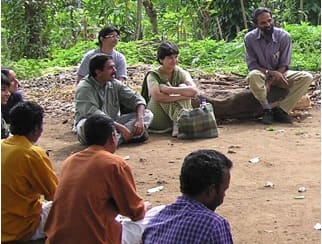
Sustainable use of biodiversity
According to the Convention on Biological Diversity, sustainable use entails the “use of biodiversity components in a manner in which ecological processes, species and genetic variability remain above thresholds needed for long-term viability”.[1]
Article 10(c) of the same Convention calls on Parties to: “…protect and encourage customary use of biological resources in accordance with traditional cultural practices that are compatible with conservation or sustainable use requirements”. The use of biological resources may concern grasslands established and maintained to allow seasonal grazing of livestock, which also provide habitats for other species. It may relate to fisheries managed as to maintain fish biodiversity, or to agricultural practices that conserve traditional crop diversity. In all these and many other cases, sustainable uses are “developed over generations, based on experience with specific places and species within the territory, the seasons and climate” and are “closely linked both to traditional knowledge as well as to a particular territory”.[2]
Many ICCAs—territories of life embed communities’ cultural and spiritual values that guide practices for the sustainable use of the various gifts of nature they contain. Such practices are rooted in the past in order to fulfil present responsibilities towards the environment and guarantee the well-being of future generations (intergenerational equity). They are a powerful tool to meet many of the UN Sustainable Development Goals[3], including eradication of poverty and hunger, and the promotion of sustainable communities, which conserve and restore biodiversity because of the social, cultural and economic benefits they derive from it.
What promotes communities’ sustainable use of biodiversity?
Sustainable uses and practices are greatly supported whenever custodian indigenous peoples and local communities are effectively engaged in decision making, have security over the long-term tenure of their territory and biodiversity,[4] and remain capable of exercising their self-determining authority over them.[5] The presence of local governance institutions and their ability to create and enforce rules responding to changing circumstances is essential to secure sustainable use (see #Governance vitality).
When communities do not hold, or are not perceived to hold, long-term rights to their territories of life, when they are denied or unduly limited in the use of its natural resources and/or when they are denied access to their traditional lands, the sustainable practices they hold are in danger of being impaired, forgotten or replaced by resentment and unsustainable attitudes. The important role for state governments is to make sustainable uses more locally beneficial than unsustainable ones. When communities are entrusted with local governance and when the benefits arising from local resources are fairly and equitably shared, sustainable use is more likely to occur.[6]
On a global scale, indigenous peoples and local communities find themselves embedded in the current capitalist economic system, whose main goal is the rapid maximization of economic profits, driving ecologically unsustainable growth. At the core of the disregard for the social and environmental impacts of profit maximization stands the occupation and colonization of collective lands and waterways and the unsustainable exploitation of gifts of nature in territories of life. All this discourages, when it does not impede, sustainable uses, even in the case of well-established communities.
Key references:
Convention on Biological Diversity, 2004b; Bélair et al., 2010; Forest People Programme, 2011; Hodges et al., 2014; Tengö et al., 2017; Wittman et al., 2017; Cooney et al., 2018; Robinson et al., 2018; Child and Cooney, 2019; Dacks et al., 2019.
[1] Convention on Biological Diversity 2004b, Addis Ababa Principles.
[2] Forest Peoples Programme, 2011, page 6.
[3] The Sustainable Development Goals (SDGs) are the United Nation’s set of 17 goals for a sustainable future, each with its respective targets (on poverty, inequality, climate, etc.), to be reached by 2030; see: https://www.un.org/sustainabledevelopment/
[4] Cooney et al., 2018.; see also #Appropriate recognition, #Land Tenure.
[5] This latter point has been highlighted by Marshall Murphree (Murphree, 2009) and stressed by Jeff Corntassel (Corntassel, 2012).
[6] Cooney et al., 2018.